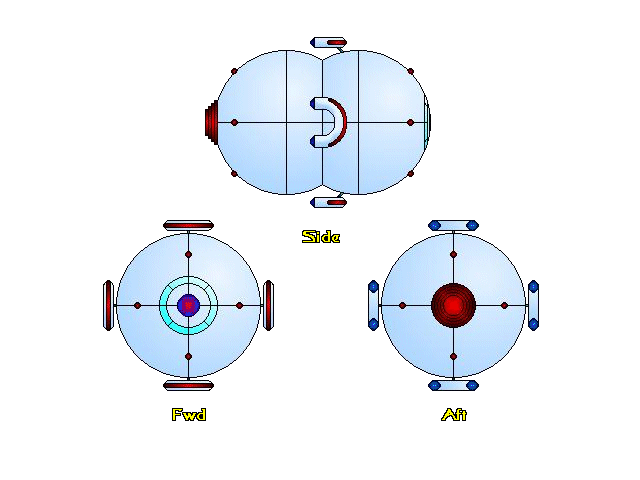

Hephaestus class
General Specifications:
Length: 56.25m
Width: 43m
Height: 43m
Max Warp: Classified
Cruise: Classified
Max. Impulse: 0.95 lightspeed
Crew: 3 officers and 8 enlisted
Armaments: Eight phaser cannon
Type: Light escort
Status: Prototype currently undergoing testing. Official status of the Hephaestus project is classified.
About Ship: Other than a few images and volumes of rumor, very few facts about this vessel are publicly acknowledged by Starfleet. Most of the following is based on extrapolation of the few facts released by Starfleet. Some of these facts may be disinformation.
The Hephaestus was developed using technology gleaned from examining the debris of the two Borg cubes known to have been destroyed in Federation space. It incorporates as much "distributed network" technology as possible, not just in the computers, but in all important subsystems, such as power distribution and life support.
The vessel itself is very compact, consisting of two partial spheres joined to create a hull with a very small surface area for the internal volume. Contrary to standard ship design, the decks are oriented with "up" in the direction of travel, rather than at 90 degrees to direction of travel. It is not known whether this is due to a technology breakthrough or other considerations. The hull itself is an inner shell of conventional composition, within multiple layers of ablative armor.
The four horseshoe-shaped objects around the vessel's "waist" are warp nacelles. The unconventional shape and number (four) of the nacelles undoubtedly creates a highly unusual warp field configuration, and may possibly allow transwarp capability. The small size of this vessel may be required due to the configuration of the warp field.
The computer does not possess a main memory core. Instead, many sub-cores are distributed throughout the ship. Each possesses only a part of the total data necessary to operate the vessel, but any three memory sub-cores do. Computer switching is by networked bioneural gelpacks enhanced with a subtle warping of subspace along all data busses. Theoretically, this system can perform calculations instantly. Processing ability is limited, however, by the necessity to output data at a usable rate.
Power generation and distribution are said to be "multiple generators". As vague as this seems, the general consensus of the scientific community is that a type of quantum flux generator is used. This theoretical generator utilizes a subspace distortion to accelerate the creation of virtual particle pairs (usually an electron and a positron). These particles form (and recombine) continuously in empty space at a very low rate. The generator accelerates the rate of pair-forming and captures them, harvesting the energy released by their recombination.
Return to the Starship Catalogue.